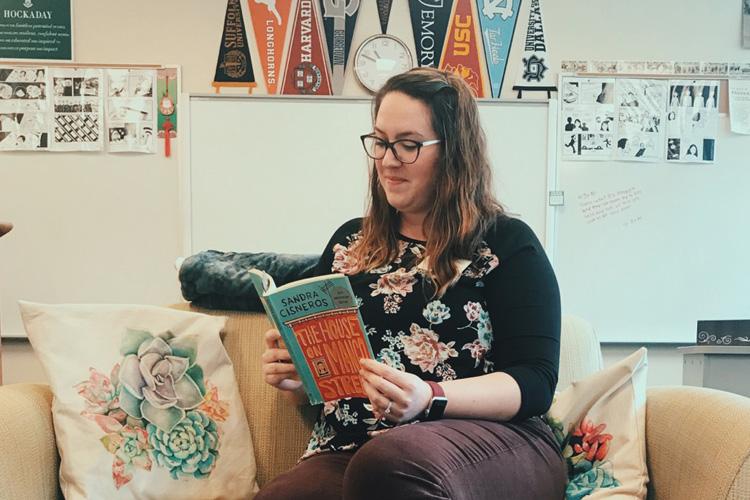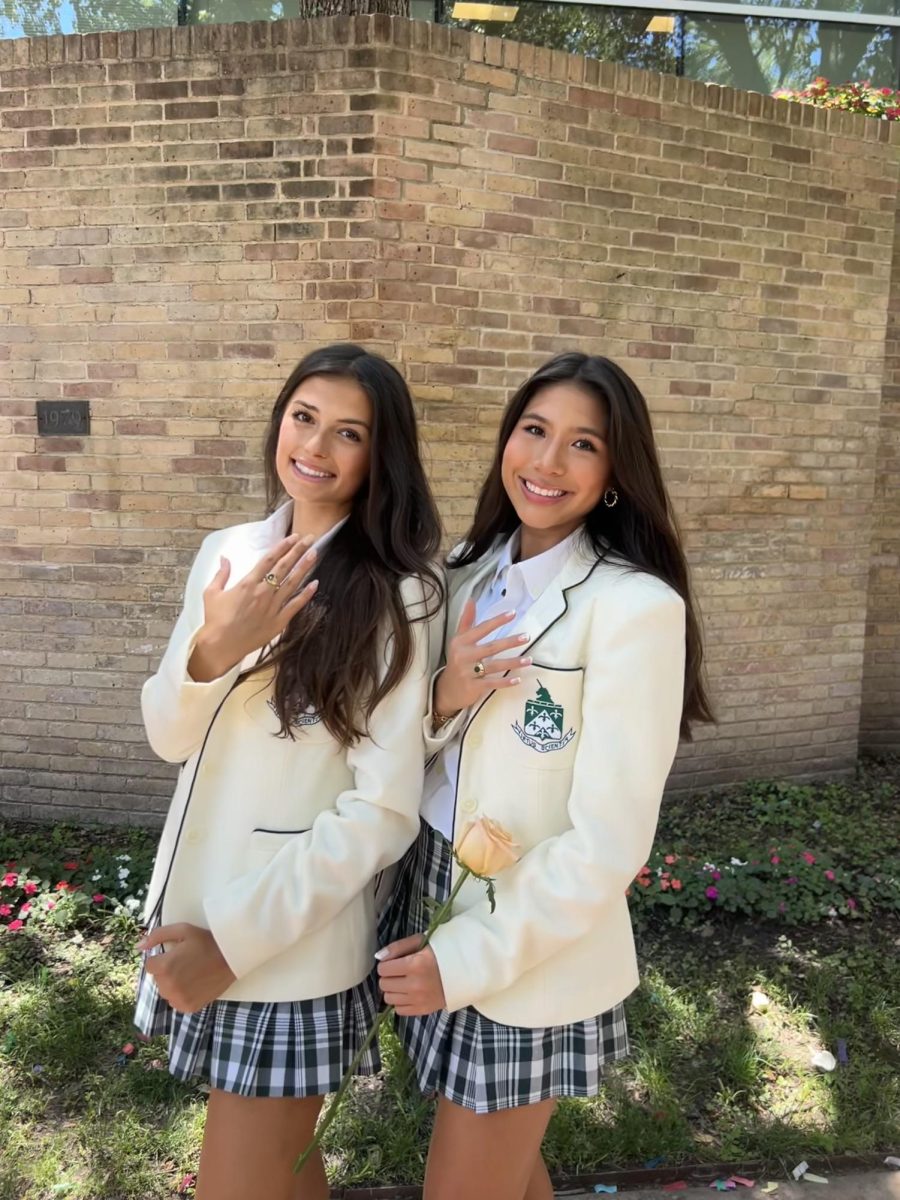PICTURED ABOVE: Hockaday English teacher Dr. Jennifer Boulanger reads Sandra Cisneros’ “The House on Mango Street” in preparation for the 2019 Interscholastic Colloquium on Feb. 13. Boulanger has worked for a year to ensure the event runs smoothly and according to plan.
On Feb. 13, what would appear to be a normal school day at 11600 Welch Road will be anything but. Several hundred people from independent schools across Dallas will be on Hockaday’s campus for the annual Interscholastic Colloquium. The author of the bestselling novel “The House on Mango Street,” Sandra Cisneros, will be in attendance as students discuss the book and share their own analytical written work.
Hockaday Upper School English teacher Dr. Jennifer Boulanger has been working to perfect the 2019 Interscholastic Colloquium to be held on Feb. 13 on Hockaday’s campus. After a year of meticulous planning, Boulanger hopes that the event will engage several communities, bringing students and teachers together to delve into the stimulating world that Cisneros paints in “The House on Mango Street” for readers of all ages and academic levels. Unlike colloquiums in the past, the author’s presence in the discussions will hopefully further excite the students participating.
“What’s so great about the concept of the colloquium is the opportunity students get to interact with people from other schools and collaborate academically,” Boulanger said. “It’s especially exciting for Hockaday students because I can imagine that it is refreshing for them to hear a boy’s perspective in a classroom.”
Pioneered in 2013 by Oakridge English teacher Jared Colley, the colloquium originally served as a forum for students across the metroplex to share their written work with others. Now, the colloquium has expanded into an event in which students dedicate their school day to attending workshops, discussion panels and performances entertaining the colloquium’s chosen text.
With schools like Hockaday, the Greenhill School, the St. Mark’s School of Texas, the Oakridge School, Cistercian Preparatory School, Fort Worth Country Day School and more in attendance at previous colloquiums, students and teachers have been given the opportunity of expanding the conversations that occur in their respective classrooms.
Greenhill Upper School English Chair Joel Garza sees the colloquium as a way of engaging his students with the unique perspectives of those outside of the walls of his classroom. While the event occurs on Feb. 13, students from all participating schools have been engaging in interscholastic discussions since the early fall via the colloquium website.
“There’s great benefit in practicing how to listen,” Garza said. “Sometimes, it’s difficult to listen to folk that you’ve known all your life—you feel as if you know what they’re going to say before they say it. When you’re listening to a new person, you have no preconceived notion, no bias for or against them. It’s a great lesson in rhetoric for the speaker too—how do I persuade a person that doesn’t know me?”
One of the main focuses of the colloquium is to provide students with the ability of sharing their own analytical work with other students. After nearly 300 students submitted essays that served to answer one of 10 prompts analyzing the “House on Mango Street,” 90 papers were accepted to be presented at the event. Junior Ivy Becker, after being accepted to share her work at the colloquium, hopes to transcend her understanding of the book by discussing Cisneros’ work with other students.
“I like that the colloquium gave us prompts to respond to,” Becker said. “Many of the essay prompts were open ended so I eagerly anticipate hearing how other students interpreted the same prompt.”
One of the reasons Cisneros’ work is so relatable is her stance between life in Chicago and her Mexican heritage. The Chicana (Mexican-American) author has never been shy about expressing her feelings of liminality and uses her own experiences to shine a light on what comprises one’s identity. The book is comprised of a series of vignettes recounting the young protagonist Esperanza’s experiences growing up in Chicago, and thus attracts an analytical potential for a variety of readers.
““The House on Mango Street” was a perfect choice for this years text,” Boulanger said. “It can appeal to people of many ages and backgrounds—a fourth grader, for example, can bring something to the table, as well a Ph.D. student.”
Becker praises the opportunity that the book has given her to further understand what it means to be a Chicana girl growing up in Chicago.
“Esperanza’s coming-of-age story resonated with me for a multitude of reasons, many of which are reflected in my paper,” Becker said. “Having delved so deeply into “The House on Mango Street” during my English class, I am really excited to share my ideas with Sandra Cisneros.”
In Cisneros’ “The House on Mango Street,” readers are exposed to a variety of topics, such as identity, coming-of-age and progress. Furthermore, the Hockaday English Department hoped to elaborate on the female-empowering aspect of the book.
“The colloquiums in the past have been fairly male-dominated texts,” Boulanger said. “While they were great novels that the students loved discussing, one of the things we were thinking about was getting a woman’s voice on there. We thought it would be great to have a living woman of color.”
Garza similarly compliments the diversity that “The House on Mango Street” provides to his students. Like Boulanger, Garza focused on a variety of different themes amongst his classes. His freshman English class read the novel as a coming of age story. He encouraged Latin American Literature students to focus on the variety of ethnic identities within the same group in the same neighborhood. Moreover, Garza hopes that the opportunity his students have been given to engage with Cisneros will further their appreciation of the text and her story.
“I don’t know how many renowned creative people my students have seen in person, so that alone would be great for them,” Garza said. “I don’t know how many renowned creative women my students have seen in person, so that would also be great for them. I don’t know how many renowned creative Mexican Americans my students have seen in person, so that would also be great for them.”
In the future, the schools participating hope to further memorialize the colloquium’s impact, but also to observe it grow into a larger-scale event that summarizes the importance of these academic conversations.
“Faculty are eager to keep it going and to preserve what works—thesis driven and creative writing options, collaborations between campuses and a long day with time to learn from each other and get to know each other,” Garza said. “With respect to content and representation, I hope that we continue bringing in a diversity of voices and texts.”
Story by Shea Duffy, Sports Editor
Photo by Sarah Schultz














